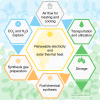Crowd oil not crude oil
- PMID: 31040282
- PMCID: PMC6491437
- DOI: 10.1038/s41467-019-09685-x
Crowd oil not crude oil
Abstract
Climate change represents an existential, global threat to humanity, yet its delocalized nature complicates climate action. Here, the authors propose retrofitting air conditioning units as integrated, scalable, and renewable-powered devices capable of decentralized CO2 conversion and energy democratization.
Conflict of interest statement
The authors declare no competing interests.
Figures





Similar articles
-
Efficient electrochemical CO2 conversion powered by renewable energy.ACS Appl Mater Interfaces. 2015 Jul 22;7(28):15626-32. doi: 10.1021/acsami.5b04393. Epub 2015 Jul 10. ACS Appl Mater Interfaces. 2015. PMID: 26121278
-
Tackling air pollution and extreme climate changes in China: Implementing the Paris climate change agreement.Environ Int. 2016 Oct;95:152-6. doi: 10.1016/j.envint.2016.04.010. Epub 2016 Apr 20. Environ Int. 2016. PMID: 27107974
-
City-integrated renewable energy for urban sustainability.Science. 2016 May 20;352(6288):922-8. doi: 10.1126/science.aad9302. Science. 2016. PMID: 27199413 Review.
-
Metal-CO2 Batteries on the Road: CO2 from Contamination Gas to Energy Source.Adv Mater. 2017 Apr;29(15). doi: 10.1002/adma.201605891. Epub 2017 Jan 20. Adv Mater. 2017. PMID: 28106932 Review.
-
Turning carbon dioxide into fuel.Philos Trans A Math Phys Eng Sci. 2010 Jul 28;368(1923):3343-64. doi: 10.1098/rsta.2010.0119. Philos Trans A Math Phys Eng Sci. 2010. PMID: 20566515 Review.
Cited by
-
Multifunctional Catalyst Combination for the Direct Conversion of CO2 to Propane.JACS Au. 2021 Sep 2;1(10):1719-1732. doi: 10.1021/jacsau.1c00302. eCollection 2021 Oct 25. JACS Au. 2021. PMID: 34723275 Free PMC article.
-
Membrane Separation Technology in Direct Air Capture.Membranes (Basel). 2024 Jan 24;14(2):30. doi: 10.3390/membranes14020030. Membranes (Basel). 2024. PMID: 38392657 Free PMC article. Review.
-
Designing a Multifunctional Catalyst for the Direct Production of Gasoline-Range Isoparaffins from CO2.JACS Au. 2021 Oct 6;1(11):1961-1974. doi: 10.1021/jacsau.1c00317. eCollection 2021 Nov 22. JACS Au. 2021. PMID: 34841412 Free PMC article.
-
Carbon monoxide and hydrogen (syngas) as a C1-building block for selective catalytic methylation.Chem Sci. 2020 Nov 20;12(3):976-982. doi: 10.1039/d0sc05404f. Chem Sci. 2020. PMID: 34163864 Free PMC article.
References
-
- BP. BP Statistical Review of World Energy. https://on.bp.com/2GSwdEa. Accessed 2018-11-08 (BP p.l.c., London, 2018).
-
- Koppelaar, R. Rembrandt Koppelaar on World Energy Consumption 1830–2010. https://deepresource.wordpress.com/2012/02/18/rembrandt-koppelaar-on-wor.... Accessed 2019-01-25 (2012).
-
- Andruleit, H. et al. Energiestudie 2016 (Bundesanstalt für Geowissenschaften und Rohstoffe BGR, Hannover, 2016).
-
- Ritchie, H. & Roser, M. Fossil fuels. https://ourworldindata.org/fossil-fuels. Accessed 2018-10-07 (2018).
-
- Clark PU, et al. Consequences of twenty-first-century policy for multi-millennial climate and sea-level change. Nat. Clim. Change. 2016;6:360–369. doi: 10.1038/nclimate2923. - DOI
Publication types
LinkOut - more resources
Full Text Sources
Other Literature Sources

